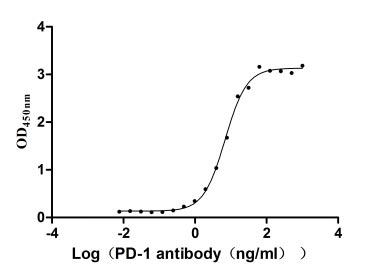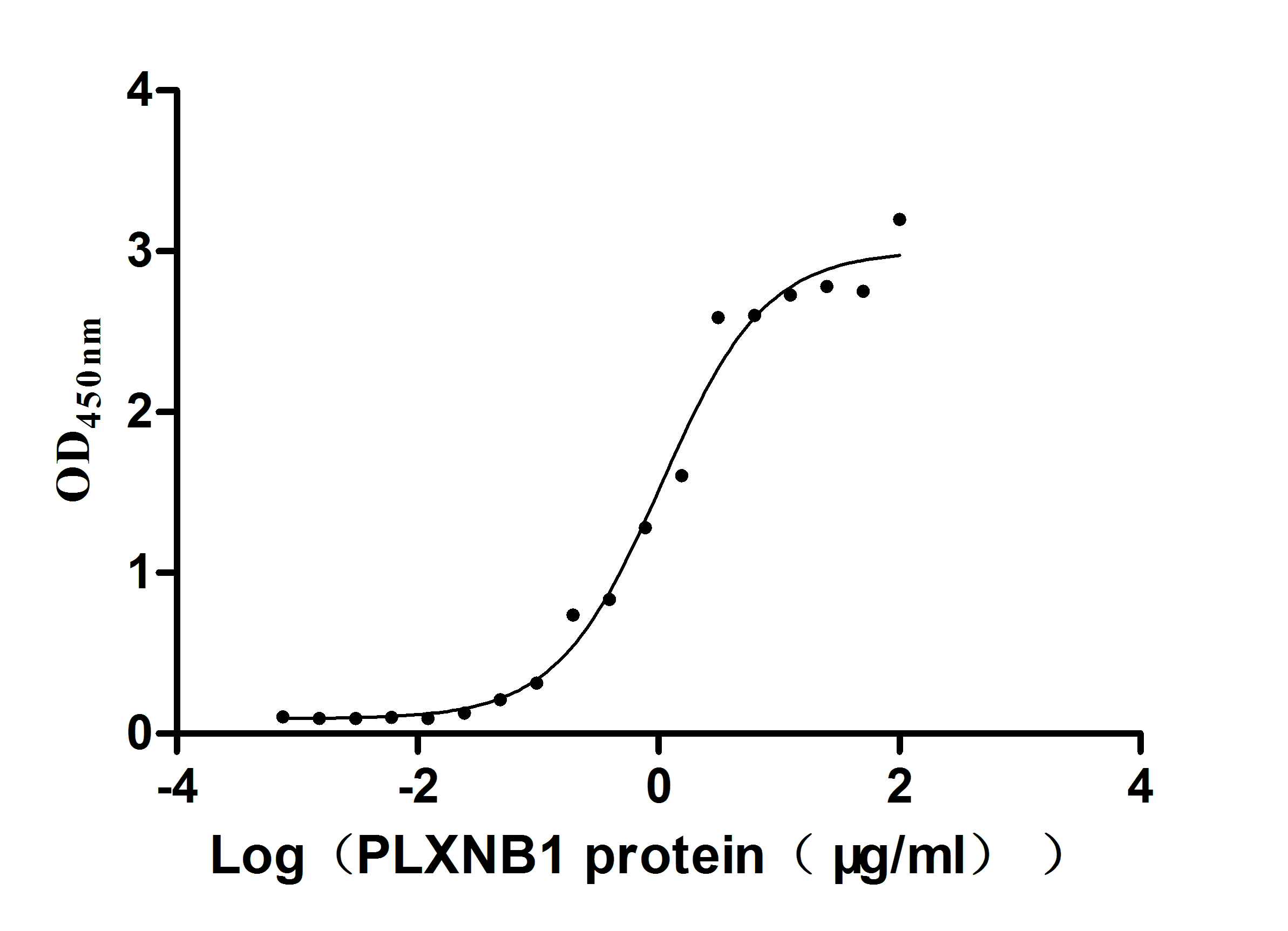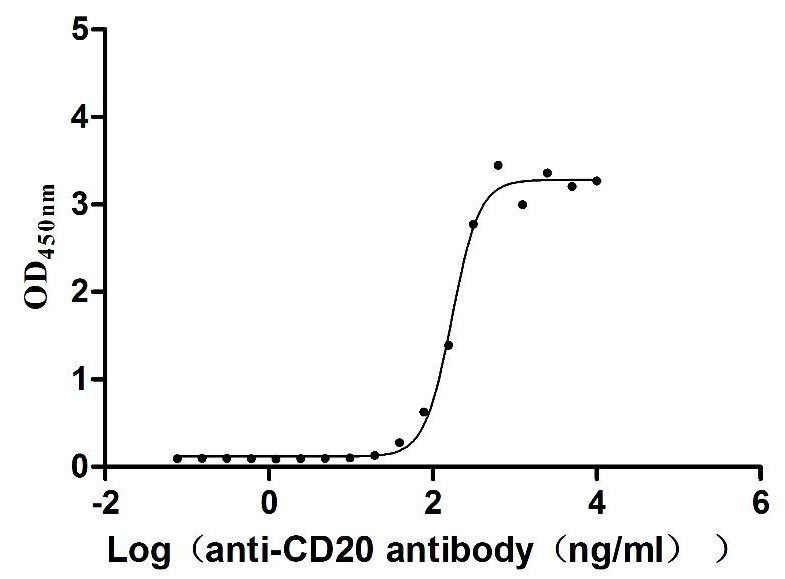Recombinant Mouse Small ubiquitin-related modifier 1 (Sumo1)
-
中文名称:小鼠Sumo1重组蛋白
-
货号:CSB-YP022948MO
-
规格:
-
来源:Yeast
-
其他:
-
中文名称:小鼠Sumo1重组蛋白
-
货号:CSB-EP022948MO
-
规格:
-
来源:E.coli
-
其他:
-
中文名称:小鼠Sumo1重组蛋白
-
货号:CSB-EP022948MO-B
-
规格:
-
来源:E.coli
-
共轭:Avi-tag Biotinylated
E. coli biotin ligase (BirA) is highly specific in covalently attaching biotin to the 15 amino acid AviTag peptide. This recombinant protein was biotinylated in vivo by AviTag-BirA technology, which method is BriA catalyzes amide linkage between the biotin and the specific lysine of the AviTag.
-
其他:
-
中文名称:小鼠Sumo1重组蛋白
-
货号:CSB-BP022948MO
-
规格:
-
来源:Baculovirus
-
其他:
-
中文名称:小鼠Sumo1重组蛋白
-
货号:CSB-MP022948MO
-
规格:
-
来源:Mammalian cell
-
其他:
产品详情
-
纯度:>85% (SDS-PAGE)
-
基因名:Sumo1
-
Uniprot No.:
-
别名:Sumo1; Smt3c; Smt3h3; Ubl1; Small ubiquitin-related modifier 1; SUMO-1; SMT3 homolog 3; Ubiquitin-homology domain protein PIC1; Ubiquitin-like protein SMT3C; Smt3C
-
种属:Mus musculus (Mouse)
-
蛋白长度:Full Length of Mature Protein
-
表达区域:2-97
-
氨基酸序列SDQEAKPST EDLGDKKEGE YIKLKVIGQD SSEIHFKVKM TTHLKKLKES YCQRQGVPMN SLRFLFEGQR IADNHTPKEL GMEEEDVIEV YQEQTGG
-
蛋白标签:Tag type will be determined during the manufacturing process.
The tag type will be determined during production process. If you have specified tag type, please tell us and we will develop the specified tag preferentially. -
产品提供形式:Lyophilized powder
Note: We will preferentially ship the format that we have in stock, however, if you have any special requirement for the format, please remark your requirement when placing the order, we will prepare according to your demand. -
复溶:We recommend that this vial be briefly centrifuged prior to opening to bring the contents to the bottom. Please reconstitute protein in deionized sterile water to a concentration of 0.1-1.0 mg/mL.We recommend to add 5-50% of glycerol (final concentration) and aliquot for long-term storage at -20℃/-80℃. Our default final concentration of glycerol is 50%. Customers could use it as reference.
-
储存条件:Store at -20°C/-80°C upon receipt, aliquoting is necessary for mutiple use. Avoid repeated freeze-thaw cycles.
-
保质期:The shelf life is related to many factors, storage state, buffer ingredients, storage temperature and the stability of the protein itself.
Generally, the shelf life of liquid form is 6 months at -20°C/-80°C. The shelf life of lyophilized form is 12 months at -20°C/-80°C. -
货期:Delivery time may differ from different purchasing way or location, please kindly consult your local distributors for specific delivery time.Note: All of our proteins are default shipped with normal blue ice packs, if you request to ship with dry ice, please communicate with us in advance and extra fees will be charged.
-
注意事项:Repeated freezing and thawing is not recommended. Store working aliquots at 4°C for up to one week.
-
Datasheet :Please contact us to get it.
靶点详情
-
功能:Ubiquitin-like protein that can be covalently attached to proteins as a monomer or a lysine-linked polymer. Covalent attachment via an isopeptide bond to its substrates requires prior activation by the E1 complex SAE1-SAE2 and linkage to the E2 enzyme UBE2I, and can be promoted by E3 ligases such as PIAS1-4, RANBP2 or CBX4. This post-translational modification on lysine residues of proteins plays a crucial role in a number of cellular processes such as nuclear transport, DNA replication and repair, mitosis and signal transduction. Involved for instance in targeting RANGAP1 to the nuclear pore complex protein RANBP2. Covalently attached to the voltage-gated potassium channel KCNB1; this modulates the gating characteristics of KCNB1. Polymeric SUMO1 chains are also susceptible to polyubiquitination which functions as a signal for proteasomal degradation of modified proteins. May also regulate a network of genes involved in palate development. Covalently attached to ZFHX3.
-
基因功能参考文献:
- These findings indicate that SUMO1-conjugation of synaptic proteins does not occur or is extremely rare and hence not detectable using current methodology. PMID: 28598330
- Study found expression of several mutated forms of SOD1 in the NSC-34 motor neuronal cells induces the formation of cytosolic and sometimes nuclear aggregates containing the SUMO-1 protein and showed that the formation of these aggregates can be modulated by action on the K75 SUMOylation site PMID: 26605782
- These findings point to a significant contribution of SUMO1 modification on neuronal function which may have implications for mechanisms involved in mental retardation and neurodegeneration. PMID: 26022678
- PML IV/ARF interaction enhances p53 SUMO-1 conjugation, activation, and senescence. PMID: 26578773
- SUMO1 accelerates the accumulation of autophagic vacuoles and promotes Abeta production. PMID: 25484073
- The present study used immunohistochemical and immunoblot analysis with the different developmental stages of mice and demonstrated the developmentally regulated distribution of SUMO1. PMID: 24639124
- The results of this study indicate that post-translational modifications of SERCA2a caused by the toxic environment of the hypertrophied and failing myocardium can be prevented by SUMO-1. PMID: 24893265
- SUMO-1 plays crucial roles for spindle organization, chromosome congression, and chromosome segregation during mouse oocyte meiotic maturation. PMID: 25123474
- Adult mice showed proportionately greater increases in SUMO-1 than the aged group. PMID: 23583339
- Increasing SUMOylation in astrocytes, by over-expression of constitutively active SUMO-1, but not its inactive mutant, abrogated Abeta-induced increase in GFAP, suggesting astrocytes require SUMO-1 conjugation to remain non-reactive. PMID: 23651519
- Sumo1 Heterozygosity Rescues Senp1 Mutant Defects. PMID: 23684609
- SUMO-1 is elevated in the brain of Alzheimer disease model mice. PMID: 22975420
- SUMOylation of pancreatic glucokinase regulates its cellular stability and activity PMID: 23297408
- Mutant lamin A/C alters the dynamics of sumo1 and thus misregulation of sumoylation may be contributing to disease progression in laminopathies. PMID: 23029315
- identification of SUMOylated proteins in the brain of His6-HA-SUMO1 knock-in mice PMID: 23213215
- SUMO1 covalently modifies Blimp-1 at lysine 816 PMID: 22555612
- Alterations in SUMO substrate conjugation may occur and global posttranslational modifications by ubiquitin may play an important role in the mechanisms underlying an Alzheimer disease model. PMID: 21843595
- SUMO-1 knockout mice developed congenital heart defects, atrial septal defects, and ventricular septal defects, coincident with the dysregulation of genes involved in cell proliferation. PMID: 21563299
- levels of SUMO1 and the SUMOylation of SERCA2a itself were greatly reduced in failing hearts PMID: 21900893
- The results of this study showed that the SUMO-1 protein interacts with mutant ataxin-1 and colocalizes with its aggregates which suggests the involvement of the SUMO-1 system in the pathogenesis of SCA1 disease. PMID: 21308649
- oncogenic Ras efficiently activates the ERK pathway both by activating Raf and by inhibiting MEK SUMOylation, thereby inducing carcinogenesis PMID: 21336309
- SUMO1 sumoylation activates p32 Pax-6 in both DNA-binding and transcriptional activities PMID: 21084637
- Studies define an important role of PIASy in hypoxia signaling through promoting HIF1alpha SUMOylation. PMID: 20661221
- SUMO-1 (small ubiquitin-related modifier) is found to regulate unfolded protein response activation and endoplasmic reticulum homeostasis. PMID: 20408817
- N4BP1 can be conjugated with SUMO1 and that this abrogates N4BP1 ubiquitylation. PMID: 20233849
- Histone deacetylase 1 is a substrate for SUMO-1 (small ubiquitin-related modifier) modification in vitro and in vivo PMID: 11960997
- activation of SUMO-1 system in polyglutamine diseases PMID: 12054600
- induction of modification by PIAS3 PMID: 12387893
- results suggest that a functional link between SUMO-1 and PR is of physiological importance for the local modulation of PR-mediated events in the ovary PMID: 14500579
- Increased levels of SUMO-1 participate in the modulation of HIF-1alpha function through sumoylation in brain and heart. PMID: 15225651
- GATA4 is a SUMO-1-targeted transcription factor and together with PIAS1 is a potent regulator of cardiac gene activity PMID: 15337742
- Testicular expression of small ubiquitin-related modifier-1 (SUMO-1) supports multiple roles in spermatogenesis: silencing of sex chromosomes in spermatocytes, spermatid microtubule nucleation, and nuclear reshaping. PMID: 15950612
- Via sumoylation SUMO-1 has an important role in the regulation of granulosa cell apoptosis during granulosa cell differentiation in the mouse ovary. PMID: 16175636
- We show that Msx1 conjugation to SUMO-1 in vivo is enhanced by an E3 SUMO ligase. PMID: 16678795
- findings show that Sumo1 is expressed in the developing lip and palate and that a Sumo1 hypomorphic allele manifests an incompletely penetrant orofacial clefting phenotype PMID: 16990542
- Results demonstrate the post-translational modification of endogenous Oct-4 by SUMO-1 and the role of sumoylation in regulating Oct-4 protein stability and function. PMID: 17496161
- The small ubiquitin-like protein SUMO-1 can modify MafB in vitro and in vivo on lysines 32 and 297. PMID: 17548468
- These results support the notion that most, if not all, SUMO-1 functions are compensated for in vivo by SUMO-2 and SUMO-3. PMID: 18573887
- The function of calcium/calmodulin-dependent serine protein kinase (CASK), a MAGUK protein, in dendritic spine formation by RNA interference, is analyzed. PMID: 18606847
- SUMO-1 further enhances the suppression of cell growth through stabilization of RbAp46 protein. This is the first report to demonstrate that SUMO-1 can suppress Ras-related cell proliferation through stabilization of RbAp46 protein. PMID: 19189660
- Maintenance of a globally elevated SUMO-1 conjugation level as revealed by immunoblot assays is a component of ischemic tolerance. PMID: 19200349
- Adenosine signaling mediates SUMO-1 modification of IkappaBalpha during hypoxia and reoxygenation. PMID: 19297320
- c-Maf can be modified at lys 33 by SUMO-1; c-Maf sumoylation contributes to immune deviation in type 1 diabetes by reducing c-Maf access to and transactivation of the IL-4 gene PMID: 19553542
显示更多
收起更多
-
亚细胞定位:Nucleus membrane. Nucleus speckle. Cytoplasm. Nucleus, PML body. Cell membrane. Nucleus.
-
蛋白家族:Ubiquitin family, SUMO subfamily
-
组织特异性:Ubiquitous.
-
数据库链接:
KEGG: mmu:22218
STRING: 10090.ENSMUSP00000088935
UniGene: Mm.362118
Most popular with customers
-
Recombinant Human Programmed cell death protein 1 (PDCD1), partial (Active)
Express system: Mammalian cell
Species: Homo sapiens (Human)
-
Recombinant Human Plexin-B1 (PLXNB1), partial (Active)
Express system: Mammalian cell
Species: Homo sapiens (Human)
-
Recombinant Dog B-lymphocyte antigen CD20 (MS4A1)-VLPs (Active)
Express system: Mammalian cell
Species: Canis lupus familiaris (Dog) (Canis familiaris)
-
Recombinant Human C-C chemokine receptor type 8 (CCR8)-VLPs (Active)
Express system: Mammalian cell
Species: Homo sapiens (Human)
-
Recombinant Human Cytotoxic and regulatory T-cell molecule (CRTAM), partial (Active)
Express system: Mammalian cell
Species: Homo sapiens (Human)
-
Recombinant Macaca fascicularis CUB domain containing protein 1 (CDCP1), partial (Active)
Express system: Mammalian cell
Species: Macaca fascicularis (Crab-eating macaque) (Cynomolgus monkey)
-
Recombinant Human Serotransferrin(TF) (Active)
Express system: Mammalian cell
Species: Homo sapiens (Human)
-
Recombinant Human C-C chemokine receptor type 9 (CCR9)-VLPs (Active)
Express system: Mammalian cell
Species: Homo sapiens (Human)




















